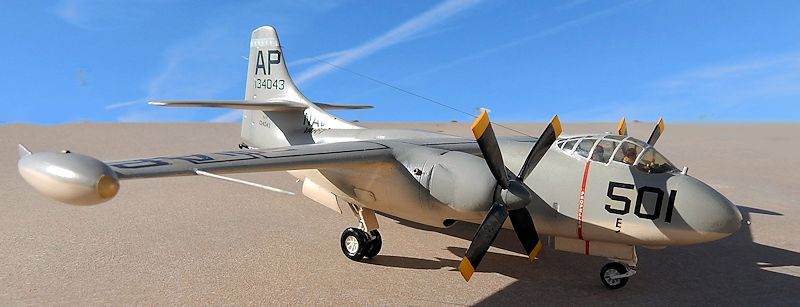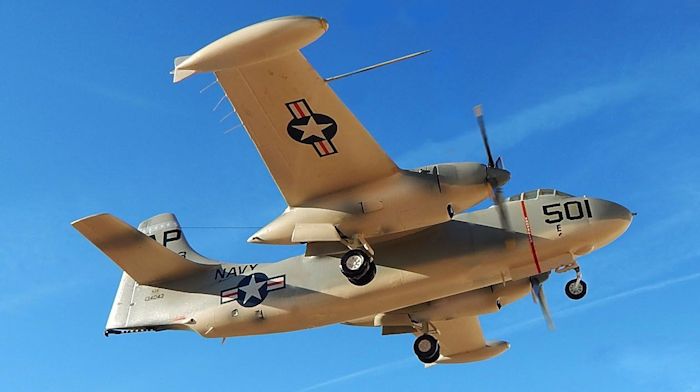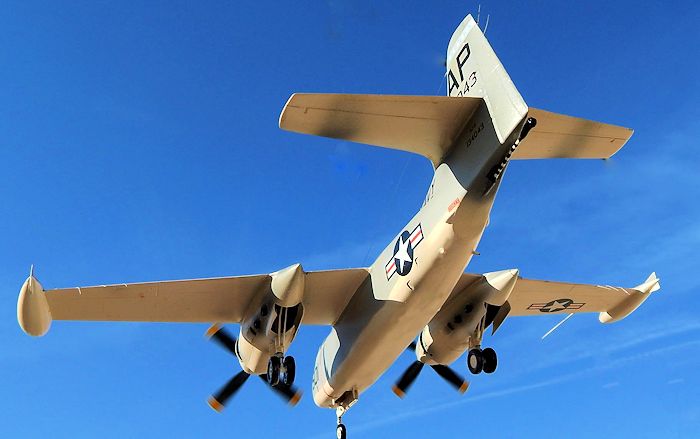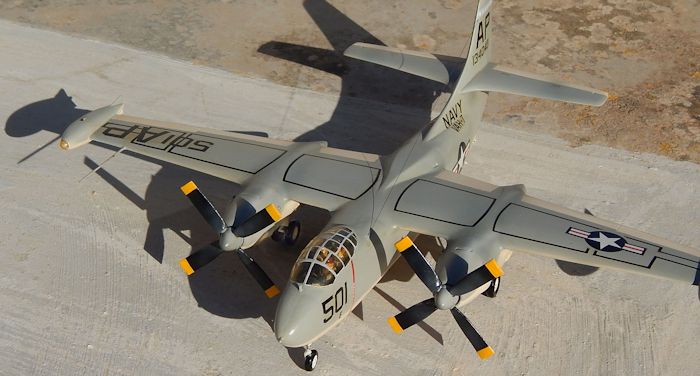
Rareplanes 1/72 AJ-2 Savage
| KIT #: | RP 6002 |
| PRICE: | |
| DECALS: | Two options |
| REVIEWER: | Carmel J. Attard |
| NOTES: | Vac-form kit with clear transparencies, detailed styrene mouldings and accurate scale plans and white metal parts undercarriage and propellers. |

| HISTORY |
Towards the end of WWII the US Navy put out specification for a heavy attack bomber capable of operating from the new large aircraft carriers planned, and capable of carrying the bulky nuclear weapons of the time.
 North American were awarded a contract for 4 examples of
their AJ-1 Savage design in June 1946, the prototype exhibiting features of
their famous Mustang fighter in the shape of the flying surfaces. The chunky
bomber was powered by 2 closely-cowled Pratt and Witney R-2800 radials and, to
bring it right into the dawning jet age, a 4,600lb J-33 turbojet was buried in
the aft fuselage to boost take off and combat speed.
North American were awarded a contract for 4 examples of
their AJ-1 Savage design in June 1946, the prototype exhibiting features of
their famous Mustang fighter in the shape of the flying surfaces. The chunky
bomber was powered by 2 closely-cowled Pratt and Witney R-2800 radials and, to
bring it right into the dawning jet age, a 4,600lb J-33 turbojet was buried in
the aft fuselage to boost take off and combat speed.
The first flight was in July 1948 and deliveries for 42 of the AJ-1 began 14 months later, going to VC-5 for carrier qualifications. A further order for 82 of the improved AJ-2 version and 18 of the camera equipped AJ-2P allowed numbers to be used at sea on USS Midway, Essex and Forrestal class carriers during the mid 1950’s.
With the birth of the all-jet Douglas A3D Skywarrior, the days of the Savage were numbered and by 1955 only 4 Squadrons remained, most of these aircraft were being converted to flight refuelling tankers with simple hose-and-reel units housed in the bomb bay. The rear jet was removed and the orifice faired over. By 1962 the AJ series had been withdrawn and remaining examples sent to the Navy storage facility at Litchfield Park.
Two surplus AJ-1 were modified for civilian use as aerial fire fighters and did sterling work in California for 6 years. Another AJ-2 was bought by Avco-Lycoming for an engine test bed and, finally, one Savage has been preserved for display by the US Navy museum.
| THE KIT |
 This is an aircraft that is of interest to modelers in
particular to those keen on Naval types and the fact that it was capable of a
variety of roles: those of a nuclear bomber, as a reconnaissance aircraft and
later on in life as a tanker these have made it all the more an important combat
type though neglected by major kit manufacturers. Thanks to Rareplanes and the
genius Gordon Stevens, (who sadly passed away recently), who made the only way
that the type would reach model shops shelves long before the Mach-2 kit was
released. The Savage has filled a gap in the line-up of 1950s Naval aircraft.
This is an aircraft that is of interest to modelers in
particular to those keen on Naval types and the fact that it was capable of a
variety of roles: those of a nuclear bomber, as a reconnaissance aircraft and
later on in life as a tanker these have made it all the more an important combat
type though neglected by major kit manufacturers. Thanks to Rareplanes and the
genius Gordon Stevens, (who sadly passed away recently), who made the only way
that the type would reach model shops shelves long before the Mach-2 kit was
released. The Savage has filled a gap in the line-up of 1950s Naval aircraft.
The kit comes in the customary Rareplanes stout box and is molded in white plastic having fine panel lines, useful accurate 1/72 scale plans covering both versions revealing how large this ship board bomber was during its time in service aboard the aft decks or parked close to the island.
| CONSTRUCTION |
The first stage is to start by scoring lightly around each molded part, then breaks the part away from the backing plastic and sand down on a large flat sheet of wet and dry sand paper. Always try to push down evenly on the part, taking care not to over sand. Heavy pressure was applied where the plastic is more condensed. For best results especially when it comes to the wings and tail planes the trailing edges are sanded very thin and sharp before cementing together.
 With the fuselage parts and the engine nacelles halves cut
and sanded down and the correct desired shape is produced I then attached short
strips of plastic along the inner joint lines to give added strength when parts
are merged together. Any open air intakes and exhaust orifices had a blanking
plate fitted inside. Molding pips were removed using a sharp blade and areas
that required filler this was used sparingly as it could soften the plastic,
which is normally of thin section.
With the fuselage parts and the engine nacelles halves cut
and sanded down and the correct desired shape is produced I then attached short
strips of plastic along the inner joint lines to give added strength when parts
are merged together. Any open air intakes and exhaust orifices had a blanking
plate fitted inside. Molding pips were removed using a sharp blade and areas
that required filler this was used sparingly as it could soften the plastic,
which is normally of thin section.
An early stage of construction was the cutting, shaping and assembly of the parts forming the cockpit area, and there is the noise cap that comes separate as an alternative nose with a camera port, which could be selected for the reconnaissance version. The jet pipe at rear or a blanking piece if selected for the later version was also prepared at this early stage.
The fuselage had forward and aft bulkheads, which were
positioned at both ends of wing roots and checked for good fit when the fuselage
halves were put together. The engine nacelles are assembled, drilling out the
exha ust pipe end ports. A fuel damp piece was added to end of nacelle, this was
made from a short piece of plastic rod.. Wheel wells were built and detailed to
one’s desire from reference material for the detail on inside.
ust pipe end ports. A fuel damp piece was added to end of nacelle, this was
made from a short piece of plastic rod.. Wheel wells were built and detailed to
one’s desire from reference material for the detail on inside.
The upper wing is a single piece from tip to tip. The wing tip tanks come separate which were fixed at a later stage. The completed nacelles were fixed to the wings and the outer lower wing parts and the inner wing parts were attached to the upper wing .The whole wing assembly needed some filler at a few places, particularly the root to engine nacelles. To prevent finishing with a drooping wing it is important at this stage to ensure that the main wing is set level when fixed to the fuselage. If this appeared to be drooping there was needed to insert a wedge at wing root between the lower wing part and the fuselage. This was however only needed if the wing piece was over sanded at edges and comes shorter. The front view of the model was checked to ensure that there is the right wing to fuselage alignment and was also checked from all angles.
The tail planes had two dowels. These were inserted inside
the fuselage to correspond with two holes drilled at tail plane section on the
other side. A small amount of filler was needed at the tail wing roots. Finally
the undercarriage was added, the nose leg is integrally cast with the nose
wheel. This was super glu ed into a small hole drilled in front end of the bay.
The leg was somewhat thin and needed some reinforcement to support, bearing in
mind the weight added to nose to make the kit balance on the nose wheel. The
main gears were naturally sturdier and were drilled in pre-drilled holes inside
the nacelle wheel wells. The metal props and spinners also added weight to
forward area.
ed into a small hole drilled in front end of the bay.
The leg was somewhat thin and needed some reinforcement to support, bearing in
mind the weight added to nose to make the kit balance on the nose wheel. The
main gears were naturally sturdier and were drilled in pre-drilled holes inside
the nacelle wheel wells. The metal props and spinners also added weight to
forward area.
Canopy transparencies were clear, two of which are included allowing any one to get it wrong once. I added three crew figures properly painted in Navy flying suits of the period.
My choice fell on the Gull gray and white finish. Using kit decals of an AJ-2 from VAH-7on board the USS Essex circa 1958. Decals were of top quality and there were also another set for the recce version that was in overall sea blue.
| CONCLUSIONS |
I have made several kits from the unique range of Rareplanes selection and the AJ-2 Savage in particular appeared to stand out for its accuracy and detail on all the kit parts. Any modeler with little experience with vac form kits can have a go at this model without any difficulty and in the end will result into a rewarding model of an important type and as one of the largest aircraft to go on flight deck of US carriers.
November 2015
Copyright ModelingMadness.com
If you would like your product reviewed fairly and fairly quickly, please contact the editor or see other details in the Note to Contributors.